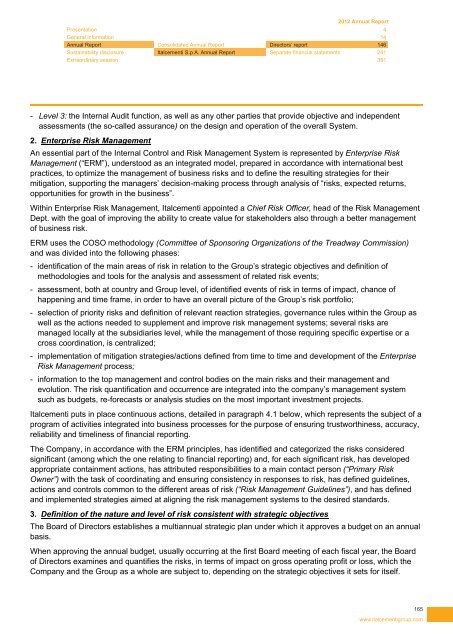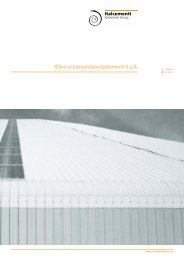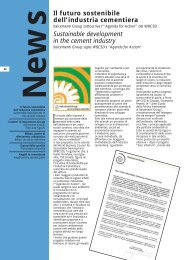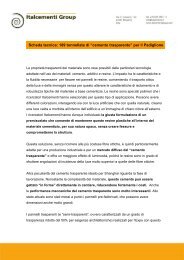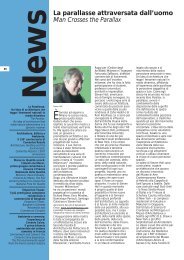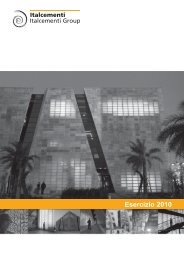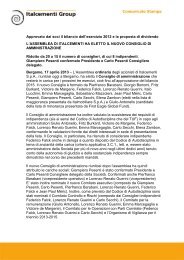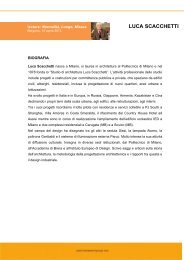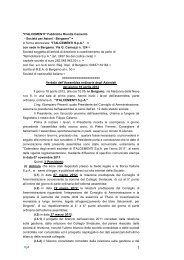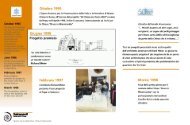2012 Annual Report - Italcementi Group
2012 Annual Report - Italcementi Group
2012 Annual Report - Italcementi Group
Create successful ePaper yourself
Turn your PDF publications into a flip-book with our unique Google optimized e-Paper software.
<strong>2012</strong> <strong>Annual</strong> <strong>Report</strong><br />
Presentation 4<br />
General information 14<br />
<strong>Annual</strong> <strong>Report</strong> Consolidated <strong>Annual</strong> <strong>Report</strong> Directors’ report 146<br />
Sustainability disclosure <strong>Italcementi</strong> S.p.A. <strong>Annual</strong> <strong>Report</strong> Separate financial statements 241<br />
Extraordinary session 351<br />
- Level 3: the Internal Audit function, as well as any other parties that provide objective and independent<br />
assessments (the so-called assurance) on the design and operation of the overall System.<br />
2. Enterprise Risk Management<br />
An essential part of the Internal Control and Risk Management System is represented by Enterprise Risk<br />
Management (“ERM”), understood as an integrated model, prepared in accordance with international best<br />
practices, to optimize the management of business risks and to define the resulting strategies for their<br />
mitigation, supporting the managers’ decision-making process through analysis of “risks, expected returns,<br />
opportunities for growth in the business”.<br />
Within Enterprise Risk Management, <strong>Italcementi</strong> appointed a Chief Risk Officer, head of the Risk Management<br />
Dept. with the goal of improving the ability to create value for stakeholders also through a better management<br />
of business risk.<br />
ERM uses the COSO methodology (Committee of Sponsoring Organizations of the Treadway Commission)<br />
and was divided into the following phases:<br />
- identification of the main areas of risk in relation to the <strong>Group</strong>’s strategic objectives and definition of<br />
methodologies and tools for the analysis and assessment of related risk events;<br />
- assessment, both at country and <strong>Group</strong> level, of identified events of risk in terms of impact, chance of<br />
happening and time frame, in order to have an overall picture of the <strong>Group</strong>’s risk portfolio;<br />
- selection of priority risks and definition of relevant reaction strategies, governance rules within the <strong>Group</strong> as<br />
well as the actions needed to supplement and improve risk management systems; several risks are<br />
managed locally at the subsidiaries level, while the management of those requiring specific expertise or a<br />
cross coordination, is centralized;<br />
- implementation of mitigation strategies/actions defined from time to time and development of the Enterprise<br />
Risk Management process;<br />
- information to the top management and control bodies on the main risks and their management and<br />
evolution. The risk quantification and occurrence are integrated into the company’s management system<br />
such as budgets, re-forecasts or analysis studies on the most important investment projects.<br />
<strong>Italcementi</strong> puts in place continuous actions, detailed in paragraph 4.1 below, which represents the subject of a<br />
program of activities integrated into business processes for the purpose of ensuring trustworthiness, accuracy,<br />
reliability and timeliness of financial reporting.<br />
The Company, in accordance with the ERM principles, has identified and categorized the risks considered<br />
significant (among which the one relating to financial reporting) and, for each significant risk, has developed<br />
appropriate containment actions, has attributed responsibilities to a main contact person (“Primary Risk<br />
Owner”) with the task of coordinating and ensuring consistency in responses to risk, has defined guidelines,<br />
actions and controls common to the different areas of risk (“Risk Management Guidelines”), and has defined<br />
and implemented strategies aimed at aligning the risk management systems to the desired standards.<br />
3. Definition of the nature and level of risk consistent with strategic objectives<br />
The Board of Directors establishes a multiannual strategic plan under which it approves a budget on an annual<br />
basis.<br />
When approving the annual budget, usually occurring at the first Board meeting of each fiscal year, the Board<br />
of Directors examines and quantifies the risks, in terms of impact on gross operating profit or loss, which the<br />
Company and the <strong>Group</strong> as a whole are subject to, depending on the strategic objectives it sets for itself.<br />
165<br />
www.italcementigroup.com


